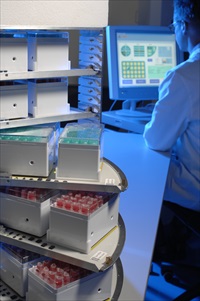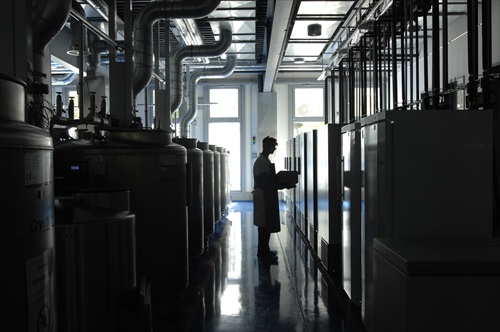Members Login

Channels
Special Offers & Promotions
Non-invasive Quality Control of Cryopreserved Samples
Since the dawn of modern medicine, human biological material has been collected, stored, and used for a variety of purposes with biological integrity ensured by cryopreservation at temperatures below -137°C. These samples are almost always unique and irreplaceable but, until now, it has been impossible to quality assure the material before use to check that thermal damage has not occurred.
 In a recently published paper, a team from Saarland University's Biophysics and Cryotechnology department in Germany has demonstrated a powerful, Raman-scattering technique for monitoring and investigating cryopreserved samples. In particular, they confirmed unambiguously the detection of ice crystals in vitreous samples in situ at temperatures below -120°C. Known as devitrification and leading almost inevitably to loss of the complete sample, this is a common side effect of transient warming events, such as the clumsy withdrawal of neighbouring samples.
In a recently published paper, a team from Saarland University's Biophysics and Cryotechnology department in Germany has demonstrated a powerful, Raman-scattering technique for monitoring and investigating cryopreserved samples. In particular, they confirmed unambiguously the detection of ice crystals in vitreous samples in situ at temperatures below -120°C. Known as devitrification and leading almost inevitably to loss of the complete sample, this is a common side effect of transient warming events, such as the clumsy withdrawal of neighbouring samples.
At the heart of their new probe is a fibre-borne imaging spectrograph from Andor, consisting of a Shamrock 303i imaging spectrograph with an iDus back-illuminated deep-depletion ('BR-DD') CCD camera. According to Professor Heiko Zimmermann who led the research, "We chose the rugged Andor iDus detector as it is rugged, established in spectroscopy and noted for its low light detection capability. We opted for the back-illuminated, deep-depletion chip in order to have access to longer illumination wavelength if cellular autofluorescence became an issue. The software supplied with the camera is very flexible and intuitive and we used the option to export the data to our bespoke software."
"Professor Zimmermann runs EuroCryo, Europe's largest research biobank and his work in detecting and monitoring changes in cryopreserved samples may be the first stage in establishing a recognised technique for retrospective proof of the absence of physical and chemical changes inside the sealed sample due to devitrification," says Antoine Varagnat, Product Specialist at Andor. "As this technique is, in principle, capable of detecting any other chemical change during storage, it is a powerful method for contactless monitoring of the status of cryopreserved samples and could lead in the future to automated monitoring of all biobank samples. Importantly, he has shown that it would be possible to take a fingerprint spectrum of every freshly preserved sample and use it as a reference to periodically confirm sample integrity during storage and upon eventual release."
Biobanks rely on the fact that aqueous samples are considered to be stably cryopreserved upon cooling to below -137°C, as this is the glass transition temperature (Tg) of amorphous water and ice crystal formation should not occur below Tg. Furthermore, chemical and biological activity and diffusion virtually stop below this temperature. If ice forms in vitrified samples due to transient infringing of the Tg, loss of the complete sample will follow. Mechanical and thermal incidents are possible in biobanking practice, for example when moving single specimens or entire sample collections, but are not detectable before rewarming.
The iDus series is the camera of choice for routine UV-Vis-NIR spectroscopy measurements, as well as more advanced, low light detection applications. The camera boasts sensor QE up to 95%, state-of-the-art Ultravac™, cooling down to -100°C, and a range of 1024 x 127 and 1024 x 256 CCD matrix with UV to NIR optimised options. Andor's modular Spectroscopy solutions encompass a wide range of high performance CCD, ICCD, EMCCD and InGaAs array detectors, as well as a comprehensive range of Research-grade spectrograph platforms.
Reference
- Daniel Dorr, Frank Stracke, and Heiko Zimmermann "Noninvasive Quality Control of Cryopreserved Samples," Biopreservation and Biobanking Vol. 10, No. 6, 529-531 (2012)
more about the iDus camera series
About Andor
Andor is a world leader in Scientific Imaging, Spectroscopy Solutions and Microscopy Systems. Established in 1989 from Queen's University in Belfast, Northern Ireland, Andor Technology now employs over 340 people in 16 offices worldwide, distributing its portfolio of over 70 products to 10,000 customers in 55 countries.
Andor’s digital cameras, designed and manufactured using pioneering techniques developed in-house, allow scientists around the world to measure light down to a single photon and capture events occurring within 1 billionth of a second. This unique capability is helping them push back the boundaries of knowledge in fields as diverse as drug discovery, toxicology analysis, medical diagnosis, food quality testing and solar energy research.
more news from Andor Technology
Media Partners



